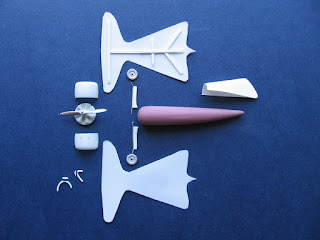
(model built and article written in 2007)
Payen Pa 101
Retro-futurism at its best
Credited as the first delta wing plane and the first delta
canard, this extremely streamlined racing machine was created by French
designer Roland Nicolas Payen. It was supposed to receive an inline engine to
fit the carefully polished lines of the plane, but what it got was a radial
that had to be adapted to the existing fuselage, creating a sight that we only
thought could come out of a comic magazine of the era.
Before you ask, yes, it did fly. It never made it to the races or speed record flights, but for sure all involved had a lot of
fun.
The first –very cautious- flight was made by Louis Massotte,
chief pilot for Bleriot, on October 1934.
In April 1935 is flown by Jean Meunier. After several
flights that demonstrate the critics the viability of the design, it had a bad
landing and although not very badly damaged it is decided to proceed instead
with other designs.
The Model:
Some of you may be already familiar with the scratch
process, visible in the photographs, with just an addendum this time: a Fimo
fuselage, a material I am told is similar to Sculpey and other “bakeable”
polymers.
Prop and wheels came from
Aeroclub, the basis for the engine was a partial from a left over of the
Northrop Gamma Williams Brother kit, as was the cowl. This last element had to
be “stretched” with the addition of a wide styrene strip and some valve cover
bumps added, as depicted in the images.
The exhaust that you can see in front of the cylinders was
made of painted soldering wire.
One funny fact is that while painting it, as I usually do on
the balcony, a wind gust blew the model out of the board but landed undamaged .
This little thing really wants to fly!


























































